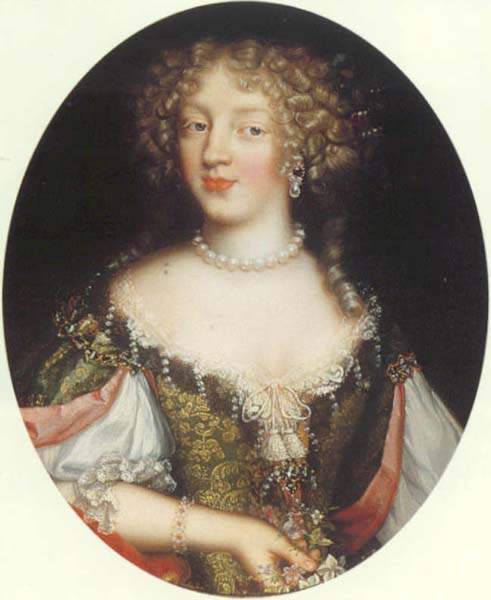- Frances Talbot, Countess of Tyrconnel
Infobox Person
name = Frances Talbot
Countess of Tyrconnel
caption = "La Belle Jennings"
birth_date = c. 1647
birth_place = Sandridge, Hertfordshire
death_date = 9th March 1730
death_place = Dublin
other_names =
known_for = Restoration-era beauty
occupation =
nationality =Frances Talbot, Countess of Tyrconnel ("
née " Jenyns, spelled Jennings in most modern references; c. 1647 –March 9 1730 ) was a noteworthy figure at the English Restoration-era court, along with her younger sister, Sarah Jennings. Once aMaid of Honour to the Duchess of York, she was twice widowed and eventually died in poverty.The daughter of Richard Jenyns and Frances Thornhurst, Frances was born at
Sandridge ,Hertfordshire ,England . Her beauty earned her thenickname of "La Belle Jennings." Macaulay describes her as “beautiful Fanny Jennings, the loveliest coquette in the brilliant Whitehall of the Restoration" [ Macaulay, "The History of England from the Accession of James the Second"] . In 1664, Frances was appointed maid of honour to the Duchess of York,Anne Hyde .Pepys records an incident in which she disguised herself as an orange seller, but was eventually recognised because of her expensive shoes.In 1665, Frances married Sir George Hamilton, son of Sir George Hamilton, 1st Baronet and Mary Butler. With him, she had two daughters:
* Frances, who married
Henry Dillon, 8th Viscount Dillon in 1687, and
* Mary (1676–1736), who marriedNicholas Barnewall, 3rd Viscount Barnewall in 1688.After Hamilton's death, Frances married an old suitor she had previously rejected, Richard Talbot in 1681. Talbot was later created
Earl of Tyrconnel in theIrish peerage and subsequently Duke of Tyrconnel, although this last title was bestowed by James II after theGlorious Revolution and was not widely recognised. They had no children.Her husband was appointed as
Lord Deputy of Ireland and the couple lived in Dublin. Following his defeat at theBattle of the Boyne , the King fled to their home and was met by Frances. King James remarked, ‘Your countrymen, madam, can run well’. She replied ‘Not quite so well as your majesty, for I see that you have won the race’ [T"he Oxford Dictionary of National Biography "] .After her husband's death in 1691, Frances was reduced to poverty and for a while, she had a dressmaker’s stall near the Royal Exchange. She dressed in white with her face covered by a white mask and was described as "the white milliner" ['The Strand, southern tributaries - continued', Old and New London: Volume 3 (1878), pp. 100-110. URL: http://www.british-history.ac.uk/report.aspx?compid=45138. Date accessed: 05 April 2008.] . In the 1840s, this was dramatized and performed as a play at Covent Garden.
Following the accession of Queen Anne, Frances (and her stepdaughter, Charlotte Talbot) had some of her husband’s former property restored to them by act of parliament — presumably assisted by her sister’s influence with the queen. She eventually retired to and died in the
Poor Clares nunnery in Dublin. She was buried in St Patrick's Cathedral in Dublin.A biography of Frances and her second husband - "Little Jennings and Fighting Dick Talbot: A Life of the Duke and Duchess of Tyrconnel" - by Philip Sergeant was published in 1913.
ee also
*
Earl of Tyrconnell Notes
Wikimedia Foundation. 2010.
